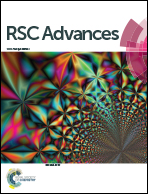Benzene hydrogenation over alumina-supported nickel nanoparticles prepared by polyol method†
Abstract
A new catalyst composed of Ni nanoparticles supported on alumina for the hydrogenation of benzene was synthesized by the ethylene glycol reduction method, and characterized by XRD, TEM, EDX, H2-chemisorption, and H2-TPD. The catalytic performances of the obtained materials have been tested in the gas-phase hydrogenation of benzene. Metal particles with a size range 2–29 nm were obtained. The metal dispersion was found to be strongly influenced by the metal loading. It was found to decrease significantly with increasing Ni loading in the catalysts. The H2-TPD study showed that the Ni//Al2O3 catalysts stored hydrogen with amounts changing with the nickel particle size. Further, the results show that the support may also actively participate in the hydrogen storage through the formation of H-spillover species. All catalysts have been found to be active and selective in the hydrogenation of benzene. The catalytic activity of these catalysts was dependent on the metal loading, particle size of the metal and the stored hydrogen in the catalyst. NiEG-05 catalyst was found to exhibit higher specific rate during the hydrogenation reaction than the other catalysts. This is attributed to the active nickel sites on the catalyst surfaces, which increase with the decrease of the metal loading.


 Please wait while we load your content...
Please wait while we load your content...